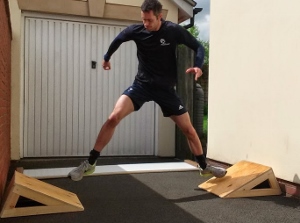Main Menu
Latest Blog Entry
User login
Bite Size Agility
 Agility for the real world
Agility for the real world
I am trying to make agility workouts more frequent, more specific and a lot shorter in duration than has previously been done for the athletes I work with.
I am starting with teaching them how to walk naturally (a recent report suggested that babies don’t spend enough waking time on their tummies, so don’t crawl as much and this leads to impaired physical coordination skills at primary school age), then faster movements, then with balls, then against opponents, then in small games.
It concerns me when players say they are doing agility drills for fitness– rapid, repeated movements, including jumping and bounding, without adequate landing ability and leg strength will lead to injury.
I would rather they work more specifically, with better quality, and then do more of those sessions each week. The warm up is a good place to work on it, see this video for an example (trainee strength and conditioning coaches).
I also find the day after competition is useful. The players are tired which means they are keen to learn new skills with good rest times, it is also a change from the usual routine and we end with some fun agility games.
Rugby agility drills
Here are some recent ideas on how I have developed this with Rugby players as an example:
Working with some rugby players on their agility I noticed how some of them do artificial movements in the hope that it makes them more agile. What I mean by artificial is a pre programmed series of steps\ head movements \ shoulder shimmies, rather than natural reactions.
Steve Morris pointed this out in my own movements, and I have used his underlying principles in going back to basic movement patterns and then training them. We will then work on putting in unplanned scenarios and small game situations to work on the patterns under pressure.
Today we worked on using skipping as a method of co ordinating hand and foot speed, specifically increasing the hand speed to make the feet move quicker. We then did some simple evading another person at walking speed with an acceleration to get past them.
We then added the hand\ shoulder speed of movement to make the feet go faster. The key point here was doing it with the hands in a ready position, and using the internal plyometric action of the shoulder joint to help generate foot speed. That way the players get used to keeping their hands up ready for catching\ passing \tackling.
The next thing was using head movement to generate change of directions- watch a baby crawl or move- the head always leads the body, not the other way round. As the players started to combine the head and fast hand actions, they started to lean forward into a better position to make a tackle, or to break a tackle.
These are natural movement patterns. the key is to enhance them, not to run the players through a series of non specific drills that don’t address these issues. By the end of the session all the players had some idea of what to do. The key is now to make this a little and often practice, not leave it for months and get it trained out of them.
Agility off the floor
There is much more to Rugby agility than using ladders! Here is a video on how to get more agile at getting up from the break down, or back into defence.
Read the detail here in How to get more agile for sport
Client Testimonials
 Blundells School
Blundells School
James has a huge breath and depth of knowledge on fitness issues. He is able to implement this knowledge into a practical course both making the task of fitness and conditioning both different and interesting from other fitness training that most are familiar with. He understands the safety issues when dealing with young adults strength and conditioning programmes. Programmes he sets are tailored to the individual needs of the group. There was a huge amount of progress made with some of these individuals in terms of their understanding of fitness and their own fitness levels.
More

